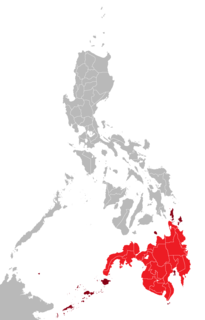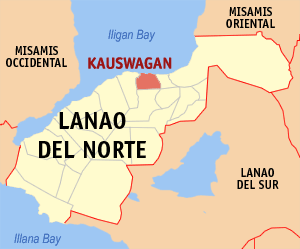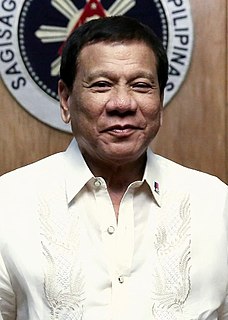
Mindanao, also commonly known as Southern Philippines, is the second-largest island in the Philippines. Mindanao and the smaller islands surrounding it make up the island group of the same name. Located in the southern region of the archipelago, as of the 2010 census, the main island was inhabited by 20,281,545 people, while the entire Mindanao island group had an estimated population of 25,537,691 (2018).

The Moro Islamic Liberation Front is a group based in Mindanao, Philippines seeking an autonomous region of the Moro people from the central government. The group has a presence in the Bangsamoro region of Mindanao, the Sulu Archipelago, Palawan, Basilan, and other neighbouring islands.

Ferdinand Emmanuel Edralin Marcos Sr. was a Filipino politician and kleptocrat who was the tenth President of the Philippines from 1965 to 1986. A leading member of the New Society Movement, he ruled as a dictator under martial law from 1972 until 1981. One of the most controversial leaders of the 20th century, Marcos' rule was infamous for its corruption, extravagance, and brutality.

The Autonomous Region in Muslim Mindanao was an autonomous region of the Philippines, located in the Mindanao island group of the Philippines, that consisted of five predominantly Muslim provinces: Basilan, Lanao del Sur, Maguindanao, Sulu, and Tawi-Tawi. It was the only region that had its own government. The region's de facto seat of government was Cotabato City, although this self-governing city was outside its jurisdiction.

Palimbang, officially the Municipality of Palimbang, is a 2nd class municipality in the province of Sultan Kudarat, Philippines. According to the 2015 census, it has a population of 90,424 people.

Kauswagan, officially the Municipality of Kauswagan, is a 5th class municipality in the province of Lanao del Norte, Philippines. According to the 2015 census, it has a population of 26,278 people.

The Moro conflict is an insurgency in the Mindanao region of the Philippines which has been ongoing since 1969, though non-Jihadist insurgency ended in 2019.

Rodrigo Roa Duterte, also known as Digong and Rody, is a Filipino politician who is the 16th and incumbent President of the Philippines and the first from Mindanao to hold the office. He is the chairperson of PDP–Laban, the ruling political party in the Philippines. Duterte took office at age 71 on June 30, 2016, making him the oldest person to assume the Philippine presidency; the record was previously held by Sergio Osmeña at the age of 65.
Haroun al-Rashid Lucman was a Filipino legislator, journalist, World War II guerilla hero, and an early proponent of Moro independence or autonomy. As Congressman of Lanao del Sur, he is best remembered for calling for the impeachment of Ferdinand Marcos 1968 because of the President's role in the Jabidah Massacre, in which government troops massaccred Tausug 68 Military trainees. When the congress could not muster enough support for the impeachment, Lucman grew convinced that Muslim Mindanao needed to become independent, and founded the Bangsamoro Liberation Organization (BMLO), which later joined forces with the Moro National Liberation Front.

The communist rebellion in the Philippines is an ongoing conflict between the Government of the Philippines (GPH) and the New People's Army (NPA), which is the armed wing of the Marxist-Leninist-Maoist Communist Party of the Philippines (CPP). The conflict is also associated with the National Democratic Front of the Philippines (NDFP), which serves as the political wing of the CPP.
The Ilaga is a Christian extremist paramilitary group based in southern Philippines. The group is predominantly composed of Visayans, embracing a form of Folk Catholicism that utilizes amulets and violence.
Maradeka is an emerging pro-democracy Muslim political organization espousing non-violent political action in the Philippines amidst the backdrop of over four decades of armed Muslim insurgency mounted by Moro National Liberation Front (MNLF) and Moro Islamic Liberation Front (MILF) in their Moro Quest for self-rule after people dissenting Philippine government treatment of Muslim minority as second class citizens and suffering years of social, economic, and political inequities called Mindanao problem
In the late 1960s, an independence movement was founded in Mindanao, the Philippines to separate the Muslim majority-Moro areas from the rest of the Philippines. The area is now called the Bangsamoro.
The Mamasapano clash was an incident that occurred during a police operation, codenamed Oplan Exodus, which took place on Sunday, January 25, 2015, at Tukanalipao, Mamasapano, Maguindanao, by Special Action Force (SAF) of the Philippine National Police (PNP) against the Bangsamoro Islamic Freedom Fighters (BIFF) and the Moro Islamic Liberation Front (MILF). The operation was intended to capture or kill wanted Malaysian terrorist and bomb-maker Zulkifli Abdhir and other Malaysian terrorists or high-ranking members of the BIFF.

The 1976 Tripoli Agreement was signed on December 23, 1976 in Tripoli, Libya by Carmelo Z. Barbero, representing the Government of the Philippines and Nur Misuari of the Moro National Liberation Front. The agreement defined autonomous administrative divisions for Muslims in the southern Philippines, the establishment of an autonomous government, judicial system for Sharia law and special security forces, and the observance of a ceasefire. The autonomous region was to have its own economic system, including an Islamic bank.

Forbidden Memory is a documentary on the study of memory and the policy of genocide, shedding light to the events surrounding the Malisbong Massacre of 1974. The film is directed by Gutierrez "Teng" Mangansakan III. It was shown during the 12th Cinema One Originals festival last November 2016.
Religious sector opposition against the dictatorship of Ferdinand Marcos included leaders and workers belonging to different beliefs and denominations.
The dictatorship of Philippine President Ferdinand E. Marcos in the 1970s and 80s is historically remembered for its record of human rights abuses, particularly targeting political opponents, student activists, journalists, religious workers, farmers, and others who fought against the Marcos dictatorship. Based on the documentation of Amnesty International, Task Force Detainees of the Philippines, and similar human rights monitoring entities, historians believe that the Marcos dictatorship was marked by 3,257 known extrajudicial killings, 35,000 documented tortures, 77 'disappeared', and 70,000 incarcerations.













